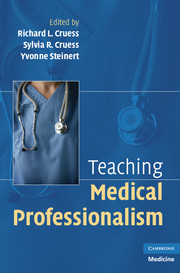Book contents
- Frontmatter
- Contents
- List of Contributors
- Foreword by William M. Sullivan
- Introduction
- PART ONE WHAT IS TO BE TAUGHT
- 1 The Cognitive Base of Professionalism
- PART TWO THEORY
- PART THREE PRINCIPLES
- PART FOUR PRACTICE: CASE STUDIES IN TEACHING PROFESSIONALISM ACROSS THE CONTINUUM
- APPENDIX A Definitions of Professionalism
- APPENDIX B Core Attributes of Professionalism
- APPENDIX C The Teaching of Professionalism: Vignettes for Discussion
- APPENDIX D A Matrix for “Matching” Teaching Methods to Attributes
- APPENDIX E Sample Grid for Use with Discussion of Vignettes
- APPENDIX F Sample Questions to Guide Discussion about the Social Contract: Small-Group Leaders' Guide with Suggested Responses
- APPENDIX G Professionalism Program for Residents: Suggested Outline for Small Group Facilitators
- APPENDIX H Sample Evaluation Form for Residents' Half-Day Program on Professionalism
- Index
- References
1 - The Cognitive Base of Professionalism
Published online by Cambridge University Press: 01 September 2009
- Frontmatter
- Contents
- List of Contributors
- Foreword by William M. Sullivan
- Introduction
- PART ONE WHAT IS TO BE TAUGHT
- 1 The Cognitive Base of Professionalism
- PART TWO THEORY
- PART THREE PRINCIPLES
- PART FOUR PRACTICE: CASE STUDIES IN TEACHING PROFESSIONALISM ACROSS THE CONTINUUM
- APPENDIX A Definitions of Professionalism
- APPENDIX B Core Attributes of Professionalism
- APPENDIX C The Teaching of Professionalism: Vignettes for Discussion
- APPENDIX D A Matrix for “Matching” Teaching Methods to Attributes
- APPENDIX E Sample Grid for Use with Discussion of Vignettes
- APPENDIX F Sample Questions to Guide Discussion about the Social Contract: Small-Group Leaders' Guide with Suggested Responses
- APPENDIX G Professionalism Program for Residents: Suggested Outline for Small Group Facilitators
- APPENDIX H Sample Evaluation Form for Residents' Half-Day Program on Professionalism
- Index
- References
Summary
As physicians, patients, and members of the general public have come to believe that medicine's professionalism is under threat, virtually all have concluded that any action to address the issue must include a major educational initiative aimed at ensuring that physicians both understand the nature of contemporary medical professionalism and live according to its precepts. As a result, there is now a substantial literature containing a variety of opinions as to how this can be best accomplished. One of the common themes that has emerged is that the approaches of the past are no longer sufficient.
For centuries, professionalism as a subject was not addressed directly. There were no courses on professionalism and it was not included in the standard medical curriculum. This is not because it was deemed unimportant. The Hippocratic Oath, subsequent codes of ethics, and a host of writers including Osler addressed the values and beliefs of the medical profession, often linking them to the word professionalism. However, it was assumed that these values and beliefs, which are the foundation of the profession, would be acquired during the process of socialization of students as they “acquire the complex ensemble of analytic thinking, skillful practice, and wise judgment.” The learning of professionalism depended heavily upon role models where students, residents, and indeed practicing physicians patterned their behavior on “individuals admired for their ways of being and acting as professionals.” While this method remains essential and powerful, by itself it is no longer felt to be adequate.
- Type
- Chapter
- Information
- Teaching Medical Professionalism , pp. 7 - 28Publisher: Cambridge University PressPrint publication year: 2008
References
- 7
- Cited by

